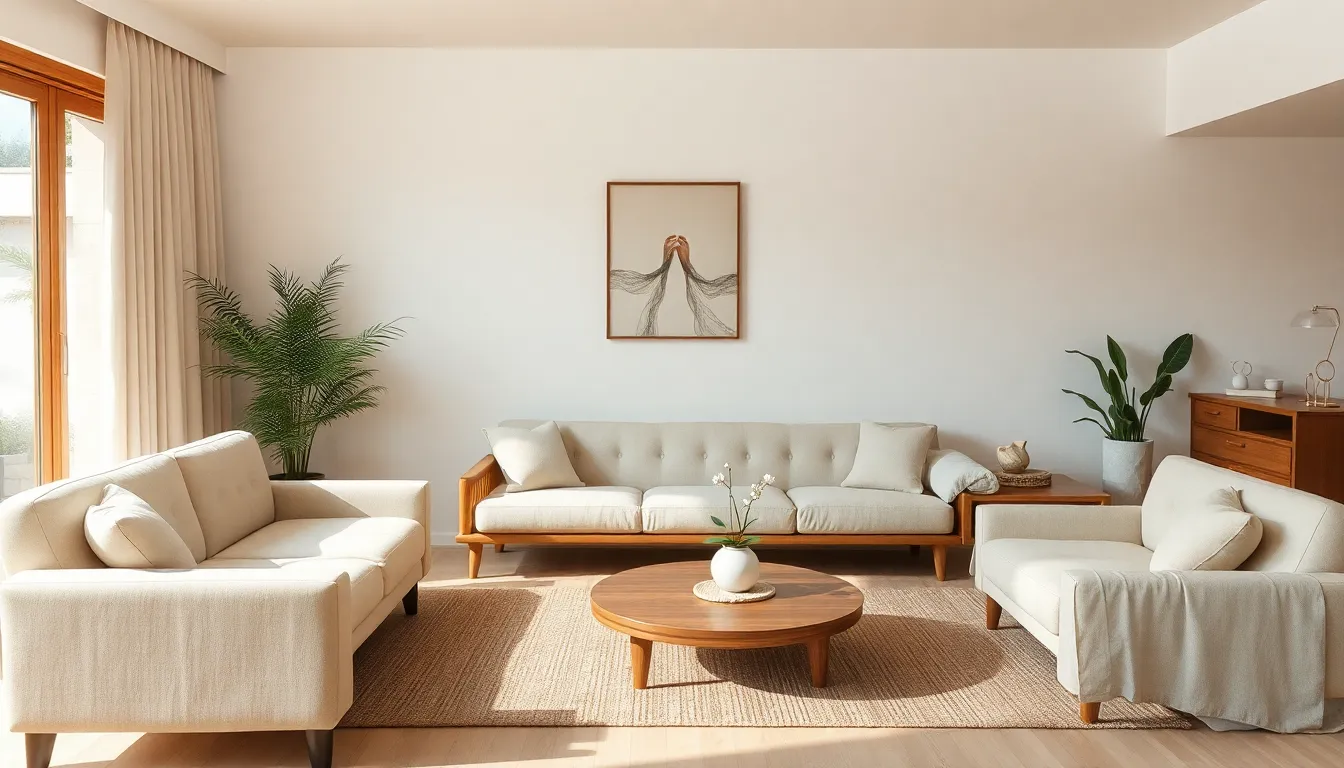Imagine stepping into a room that feels like a gentle hug from a fluffy cloud. That’s the magic of a Zen-inspired space. It’s not just about minimalism or a few strategically placed plants; it’s a lifestyle choice that transforms chaos into calm. In a world where stress seems to be the default setting, creating a sanctuary at home can be the ultimate act of self-care.
Picture this: soft lighting, soothing colors, and just the right amount of silence to hear your own thoughts. A Zen-inspired space invites tranquility and creativity while making your neighbors wonder if you’ve got a secret stash of incense. Whether you’re looking to meditate, work, or just binge-watch your favorite show, this approach to design can elevate any room from “meh” to “ahhh.” Let’s dive into how to cultivate your own slice of serenity.
Table of Contents
ToggleUnderstanding Zen-Inspired Space
Zen-inspired spaces focus on simplicity and harmony. These environments emphasize the connection between the individual and their surroundings.
Principles of Zen Design
Minimalism defines Zen design principles. Clean lines and uncluttered spaces promote a sense of calm. Natural materials like wood and stone integrate warm, organic elements. Balance in color and layout enhances visual tranquility. Soft lighting creates an inviting atmosphere. Incorporating nature through plants or natural views fosters well-being. Each component contributes to an overall feeling of serenity.
Benefits of a Zen-Inspired Space
A Zen-inspired space offers numerous benefits. Stress reduction stands as a primary advantage, as tranquil environments lower anxiety. Improved focus occurs in organized, calm settings, enhancing productivity. Creativity flourishes in peaceful atmospheres, promoting innovative thinking. Connection with nature cultivates mindfulness, improving mental clarity. Lastly, rejuvenation happens when one embraces simplicity and peace, leading to greater emotional stability.
Creating a Zen-Inspired Space at Home

Creating a tranquil environment enhances well-being and promotes relaxation. A Zen-inspired space focuses on simplicity, harmony, and natural elements.
Choosing the Right Colors
Selecting calming colors plays a crucial role in establishing a serene atmosphere. Soft blues and greens evoke feelings of peace and tranquility. Utilizing neutral shades like beige or white creates a clean, uncluttered backdrop. Consider incorporating earth tones, such as warm browns and soft grays, to enhance the connection with nature. Balance bright and muted hues to maintain visual interest without overwhelming the senses. Opt for color schemes that induce relaxation and support mindfulness practices. Choose colors that resonate personally, creating a sanctuary tailored to individual needs.
Minimalistic Furniture Selection
Furniture choices directly impact the overall feel of a Zen-inspired space. Prioritize functional pieces that serve a purpose without adding clutter. Select low-profile furniture, which fosters a sense of spaciousness and calm. Natural materials, such as wood and bamboo, create warmth while maintaining simplicity. Choose items with clean lines to promote an organized appearance. Incorporating multi-functional furniture maximizes space efficiency and minimizes visual distraction. Every selected piece should encourage a sense of peace and comfort, aligning with the principles of minimalism.
Incorporating Nature into a Zen-Inspired Space
Incorporating nature enhances the peaceful essence of a Zen-inspired space. Natural elements like plants and water features provide calming aesthetics and improve air quality.
Indoor Plants
Indoor plants contribute significantly to a Zen atmosphere. They bring a sense of life and vibrancy into the space. Options like snake plants, peace lilies, and ferns thrive in various lighting conditions. Their green hues create a soothing visual experience while purifying the air. Furthermore, placing plants in ceramic pots or wooden containers emphasizes organic materials, reinforcing Zen principles. Incorporate a variety of shapes and sizes for visual interest without overcrowding the area. Regular maintenance, such as watering and pruning, fosters a deeper connection to nature and promotes mindfulness.
Water Features
Water features introduce tranquil sounds and movement to a Zen-inspired space. Options like small fountains or tabletop waterfalls serve as focal points while enhancing relaxation. The gentle sound of flowing water acts as natural white noise, masking distractions and promoting serenity. Invest in features that fit the space, ensuring they remain proportionate to the room’s size. Incorporating pebbles or stones around these features enhances the natural look. Adjust the water flow to create a soothing ambiance that complements activities like meditation or reading. Embracing such elements solidifies the connection between indoor environments and nature.
The Role of Lighting in a Zen-Inspired Space
Lighting plays a crucial role in establishing a Zen-inspired environment. Proper lighting enhances tranquility and promotes relaxation, allowing individuals to connect with their surroundings.
Natural Light vs. Artificial Light
Natural light provides a warm ambiance while promoting well-being. It creates an immediate connection to the outdoors, offering numerous health benefits. Sheer curtains or strategically placed mirrors can amplify sunlight, brightening the space. Alternatively, artificial light complements natural sources and can be tailored to specific needs. LED bulbs mimic daylight and can adjust color temperatures. Dimmable fixtures allow flexibility, making them ideal for various activities, such as meditation or reading. Both types of light contribute to the calming atmosphere essential in a Zen-inspired space.
Mood Lighting Techniques
Various mood lighting techniques help establish a serene atmosphere. Soft glow lamps create a cozy environment, perfect for relaxation. Task lighting in work areas ensures focus while maintaining tranquility. Incorporating candles or himalayan salt lamps adds a gentle, flickering light, enhancing the overall ambiance. Adjustable wall sconces can provide subtle illumination while highlighting the space’s clean lines. Layering different light sources establishes depth and creates a harmonious balance between functionality and aesthetics.
Creating a Zen-inspired space is more than just an aesthetic choice; it’s a pathway to inner peace and well-being. By embracing simplicity and harmony, individuals can transform their environments into sanctuaries that nurture mindfulness and creativity.
Incorporating natural elements, soft lighting, and balanced colors fosters a serene atmosphere that invites relaxation and focus. Each thoughtful detail contributes to a holistic experience that enhances daily life.
Ultimately, cultivating a Zen-inspired space is a personal journey that empowers individuals to reconnect with themselves and their surroundings, promoting a lifestyle rooted in tranquility and balance.


